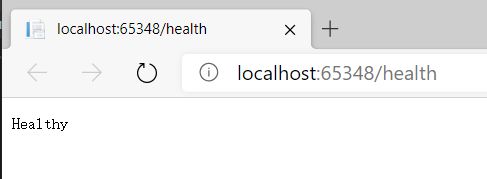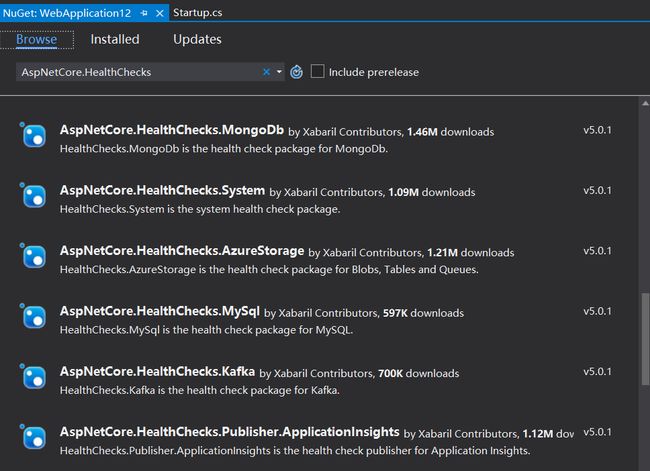健康检查 常用于判断一个应用程序能否对 request 请求进行响应,ASP.Net Core 2.2 中引入了 健康检查 中间件用于报告应用程序的健康状态。
ASP.Net Core 中的 健康检查 落地做法是暴露一个可配置的 Http 端口,你可以使用 健康检查 去做一个最简单的活性检测,比如说:检查网络和系统的资源可用性,数据库资源是否可用,应用程序依赖的消息中间件或者 Azure cloud service 的可用性 等等,这篇文章我们就来讨论如何使用这个 健康检查中间件。
注册健康检查服务
要注册 健康检查 服务,需要在 Startup.ConfigureServices 下调用 AddHealthChecks 方法,然后使用 UseHealthChecks 将其注入到 Request Pipeline 管道中,如下代码所示:
public class Startup
{
// This method gets called by the runtime. Use this method to add services to the container.
public void ConfigureServices(IServiceCollection services)
{
services.AddControllersWithViews();
services.AddHealthChecks();
}
// This method gets called by the runtime. Use this method to configure the HTTP request pipeline.
public void Configure(IApplicationBuilder app, IWebHostEnvironment env)
{
app.UseHealthChecks("/health");
app.UseStaticFiles();
app.UseRouting();
app.UseEndpoints(endpoints =>
{
endpoints.MapControllerRoute(
name: "default",
pattern: "{controller=Home}/{action=Index}/{id?}");
});
}
}
上图的 /health 就是一个可供检查此 web 是否存活的暴露端口。
其他服务的健康检查
除了web的活性检查,还可以检查诸如:SQL Server, MySQL, MongoDB, Redis, RabbitMQ, Elasticsearch, Hangfire, Kafka, Oracle, Azure Storage 等一系列服务应用的活性,每一个服务需要引用相关的 nuget 包即可,如下图所示:
然后在 ConfigureServices 中添加相关服务即可,比如下面代码的 AddSqlServer。
public void ConfigureServices(IServiceCollection services)
{
services.AddControllersWithViews();
services.AddHealthChecks().AddSqlServer("server=.;database=PYZ_L;Trusted_Connection=SSPI");
}
自定义健康检查
除了上面的一些开源方案,还可以自定义实现 健康检查 类,比如自定义方式来检测 数据库 或 外部服务 的可用性,那怎么实现呢? 只需要实现系统内置的 IHealthCheck 接口并实现 CheckHealthAsync() 即可,如下代码所示:
public class MyCustomHealthCheck : IHealthCheck
{
public async Task CheckHealthAsync(HealthCheckContext context,
CancellationToken cancellationToken = default(CancellationToken))
{
bool canConnect = IsDBOnline();
if (canConnect)
return HealthCheckResult.Healthy();
return HealthCheckResult.Unhealthy();
}
}
这里的 IsDBOnline 方法用来判断当前数据库是否是运行状态,实现代码如下:
private bool IsDBOnline()
{
string connectionString = "server=.;database=PYZ_L;Trusted_Connection=SSPI";
try
{
using (SqlConnection connection = new SqlConnection(connectionString))
{
if (connection.State != System.Data.ConnectionState.Open) connection.Open();
}
return true;
}
catch (System.Exception)
{
return false;
}
}
然后在 ConfigureServices 方法中进行注入。
public void ConfigureServices(IServiceCollection services)
{
services.AddControllersWithViews();
services.AddHealthChecks().AddCheck("sqlcheck");
}
public void Configure(IApplicationBuilder app, IWebHostEnvironment env)
{
app.UseRouting().UseEndpoints(config =>
{
config.MapHealthChecks("/health");
});
app.UseStaticFiles();
app.UseRouting();
app.UseEndpoints(endpoints =>
{
endpoints.MapControllerRoute(
name: "default",
pattern: "{controller=Home}/{action=Index}/{id?}");
});
}
接下来可以浏览下 /health 页面,可以看出该端口自动执行了你的 MyCustomHealthCheck 方法,如下图所示:
可视化健康检查
上面的检查策略虽然好,但并没有一个好的可视化方案,要想实现可视化的话,还需要单独下载 Nuget 包: AspNetCore.HealthChecks.UI , HealthChecks.UI.Client 和 AspNetCore.HealthChecks.UI.InMemory.Storage,命令如下:
Install-Package AspNetCore.HealthChecks.UI Install-Package AspNetCore.HealthChecks.UI.Client Install-Package AspNetCore.HealthChecks.UI.InMemory.Storage
一旦包安装好之后,就可以在 ConfigureServices 和 Configure 方法下做如下配置。
public class Startup
{
// This method gets called by the runtime. Use this method to add services to the container.
public void ConfigureServices(IServiceCollection services)
{
services.AddControllersWithViews();
services.AddHealthChecks();
services.AddHealthChecksUI().AddInMemoryStorage();
}
// This method gets called by the runtime. Use this method to configure the HTTP request pipeline.
public void Configure(IApplicationBuilder app, IWebHostEnvironment env)
{
app.UseRouting().UseEndpoints(config =>
{
config.MapHealthChecks("/health", new HealthCheckOptions
{
Predicate = _ => true,
ResponseWriter = UIResponseWriter.WriteHealthCheckUIResponse
});
});
app.UseHealthChecksUI();
app.UseStaticFiles();
app.UseRouting();
app.UseEndpoints(endpoints =>
{
endpoints.MapControllerRoute(
name: "default",
pattern: "{controller=Home}/{action=Index}/{id?}");
});
}
}
最后还要在 appsettings.json 中配一下 HealthChecks-UI 中的检查项,如下代码所示:
{
"Logging": {
"LogLevel": {
"Default": "Information",
"Microsoft": "Warning",
"Microsoft.Hosting.Lifetime": "Information"
}
},
"AllowedHosts": "*",
"HealthChecks-UI": {
"HealthChecks": [
{
"Name": "Local",
"Uri": "http://localhost:65348/health"
}
],
"EvaluationTimeOnSeconds": 10,
"MinimumSecondsBetweenFailureNotifications": 60
}
}
最后在浏览器中输入 /healthchecks-ui 看一下 可视化UI 长成啥样。
使用 ASP.Net Core 的 健康检查中间件 可以非常方便的对 系统资源,数据库 或者其他域外资源进行监控,你可以使用自定义检查逻辑来判断什么样的情况算是 Healthy,什么样的算是 UnHealthy,值得一提的是,当检测到失败时还可以使用失败通知机制,类似 github 发布钩子。
译文链接:https://www.infoworld.com/article/3379187/how-to-implement-health-checks-in-aspnet-core.html
到此这篇关于详解如何在ASP.Net Core中实现健康检查的文章就介绍到这了,更多相关ASP.Net Core 健康检查内容请搜索脚本之家以前的文章或继续浏览下面的相关文章希望大家以后多多支持脚本之家!



